Eric C. Sheninger's Blog, page 18
November 14, 2021
Curiosity: The Ultimate Learning Trigger
When I reflect on my childhood there were numerous profound experiences that impacted my trajectory. I still vividly remember spending my summers in Ocean City, NJ where one set of my grandparents resided. To this day there is just something magical about the beach. My grandfather Robert Lewis had many hobbies that intrigued me and my brothers. One of them was making jewelry. While could craft any stone into something beautiful, he often chose amethyst as purple was my grandmother’s favorite color. He was also fond of using opals, which my mom really loved. It was so interesting that we asked for a rock polishing machine so that we could attempt to make our own jewelry. Though not as successful as him, we did create some interesting pieces.
There was another hobby of his that captured my attention even more and that was surf fishing. I really didn’t care if he even caught anything as long as I was able to venture with him to the beach and look for shells or sea creatures. On successful days I would bring back live sea stars and hermit crabs in a bucket. It wasn’t until I was a bit older that I discovered this wasn’t the best of ideas. When my grandfather did catch fish, he would put them in either a bucket or a small gully for us to watch. Even though his intended target was flounder he always seemed more successful hooking either sand sharks or blue-clawed crabs. Nonetheless, I got my parents to buy a field guide so I could learn more about local marine life. While my time with him was much too short, his influence on me was and still is strong. I eventually pursued and received a degree in marine biology.
Each example above shows the power of curiosity as a trigger for learning. Whether it was the hobbies of my grandfather or just being on the beach, each experience entailed observations and questions, which led to further exploration fueled by intrinsic motivation. Brain research validates how critical curiosity can be when it comes to learning. Here is an excerpt from a 2014 article in Scientific American by Daisy Yuhas:
“Researchers asked 19 participants to review more than 100 questions, rating each in terms of how curious they were about the answer. Next, each subject revisited 112 of the questions—half of which strongly intrigued them whereas the rest they found uninteresting—while the researchers scanned their brain activity. During the scanning session participants would view a question then wait 14 seconds and view a photograph of a face totally unrelated to the trivia before seeing the answer. Afterward the researchers tested participants to see how well they could recall and retain both the trivia answers and the faces they had seen.
They discovered that greater interest in a question would predict not only better memory for the answer but also for the unrelated face that had preceded it. A follow-up test one day later found the same results—people could better remember a face if it had been preceded by an intriguing question. Somehow curiosity could prepare the brain for learning and long-term memory more broadly. This, it can be concluded that Curiosity boosts people's ability to learn and retain new information, thanks to key reward and memory centers in the brain. ... For questions that they were curious about, participants remembered answers better than for questions in which they were less interested.”
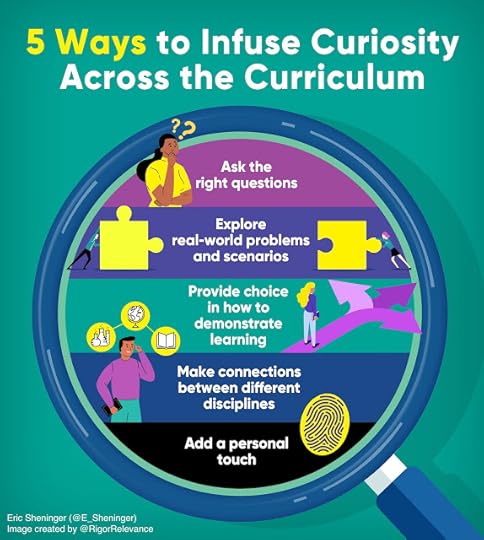
Here are some ways to seamlessly infuse curiosity across the curriculum:
Ask the right questions (refer to these question stems found in Disruptive Thinking in Our Classrooms)Explore real-world problems and scenariosProvide choice in how to demonstrate learning Make connections between different disciplines Add a personal touch (try these personalized strategies)There is also a great, free resource that can assist with all the above in the form of Verizon Innovative Learning HQ. Packed with lesson ideas, AR/VR apps, and professional development this next-generation online portal can help all educators unleash creativity to trigger meaningful learning amongst all learners. In the words of Ken Robinson, “Curiosity is the engine of achievement.”
Sponsored post
November 7, 2021
Upgrading the KWL Chart
There are many strategies at the disposal of a teacher to help students learn. The anticipatory set functions as a hook at the beginning of the lesson for motivation, while closure ties everything together. Routine checks for understanding provide valuable feedback as to whether or not instruction is hitting the mark. Turn and talk allows for needed discourse. While all of these are pedagogically sound, they don’t matter much if kids are unsure of where the lesson is going. Learning targets provide valuable clarity on expectations.
Why did we learn this and what will I be able to do when I’ve finished this lesson?What idea, topic, or subject is important for me to learn and understand so that I can do this?How will I show that I can do this, and how well will I have to do it to demonstrate that I have learned something new?Here is something I shared in Disruptive Thinking in Our Classrooms:
Developing learning targets does not go far enough, though. Learn¬ers need to understand the point of a lesson just as much as a teacher or administrator. Imparting relevance through a specific context and appli¬cation helps achieve this. However, everything must be tied together from the learner’s point of view. This is why closure and reflection at the end of the lesson are crucial. Either or both of these elements can be tied to the use of a KWL chart.
There are variations of this resource, but for the most part, it is commonly structured in the following way:
K – What I know.
W – What I want to know or what I wonder.
L – What I learned.
There is always an opportunity to build upon existing resources to make them more effective and meaningful. Hence the evolution of the KWL to KWHLAQ. Below, you will see what this chart looks like as presented in the book and the various question stems to spark and cultivate disruptive thinking. While I have developed some question stems for each category, educators can expand on them to align with local curriculum.
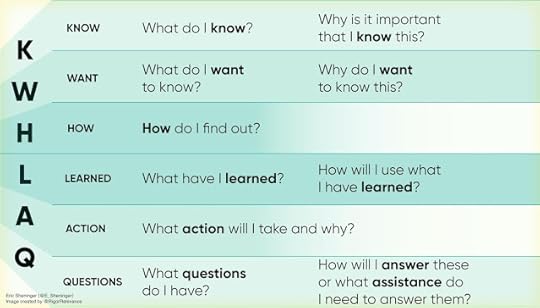
From a pedagogical standpoint, it is essential to build reflection into daily learning activities to bring the learning process full circle. Bottom line: everyone—especially our students—should understand the point of a lesson. The KWHLAQ chart not only connects to prior learning and interests but also provides the means to showcase learning.
October 31, 2021
Different Ways to Show Learning
For many of us, our preparation to become teachers consisted of courses focusing on classroom management, lesson design, grading, and proven strategies that had withstood the test of time. We were also exposed to learning style theory and the many benefits it had on meeting the diverse needs of students. To this day, it is still heavily referenced, even though it has been debunked extensively. Cindi May shared the following in Scientific American:
Just because a notion is popular, however, doesn't make it accurate. A recent review of the scientific literature on learning styles found scant evidence to clearly support the idea that outcomes are best when instructional techniques align with individuals' learning styles. In fact, several studies contradict this belief. It is clear that people have a strong sense of their own learning preferences (e.g., visual, kinesthetic, intuitive), but it is less clear that these preferences matter.
There is little scientific support for this fashionable idea—and stronger evidence for other learning strategies.
Research continues to provide further evidence that the conventional wisdom about learning styles should be rejected by educators and students alike (Kirschner, 2017; Husmann & O'Loughlin, 2018; Riener & Willingham, 2010). While this challenge to conventional wisdom might be hard to swallow, some good news comes in the form of a silver lining. There isn't one best way to learn as the path and preference are different for everyone. Hence the need to incorporate an array of strategies that pull on the strengths of some learners while addressing weaknesses in others.
In Disruptive Thinking in Our Classrooms, I laid out an array of personalized strategies that can be implemented after a mini-lesson is facilitated. While these take some planning upfront, there are some simpler techniques that can be readily integrated into any lesson in the form of voice and choice. When reviewing prior learning, checking for understanding, or closing lessons, allow students to choose how to show what they have learned through the following means:
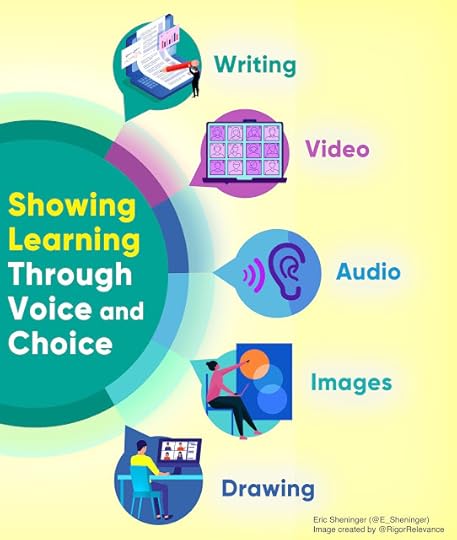 Writing (digital tools, individual whiteboards)Video (Flipgrid, Padlet, Seesaw)Audio (Padlet, Seesaw)Images (Padlet Jamboard)Drawing (Nearpod, Pear Deck, Padlet, individual whiteboards)
Writing (digital tools, individual whiteboards)Video (Flipgrid, Padlet, Seesaw)Audio (Padlet, Seesaw)Images (Padlet Jamboard)Drawing (Nearpod, Pear Deck, Padlet, individual whiteboards)While tech presents a myriad of options for students to show learning, traditional mini-whiteboards can also be used in some cases. None of the pathways above are meant to replace summative assessments, but using varied formative means caters to a learner's preference by giving them the best opportunity to show what they have learned. It builds confidence, fosters creativity, and empowers students during lessons.
Husmann, P.R., and V.D. O'Loughlin. 2019. "Another Nail in the Coffin for Learning Styles? Disparities among Undergraduate Anatomy Students' Study Strategies, Class Performance, and Reported Vark Learning Styles." Anatomical Sciences Education 12, 6–19.
Kirschner, P. 2017. "Stop Propagating the Learning Styles Myth." Computers and Education 106, 166–171.
Riener, C., and D.T. Willingham, 2010. "The Myth of Learning Styles." Change: The Magazine of Higher Learning 42(5), 32–35.
October 24, 2021
Alternative Learning: Supporting Our At-Promise Students
Long gone are the days that a one-size-fits-all education program could even be considered an effective option to meet the needs of every student. While an array of successful strategies associated with more traditional methodologies still have value today, we need to rethink how and when they are used. What happens in the classroom will always be of utmost importance, but specific programs need to be in place that serves the diverse needs of all students who are the most vulnerable. While a standardized classroom setting could be for some, others need more individualized supports. Students who find themselves receiving many detentions, suspensions, expulsions, or even incarcerations still deserve a quality education. Alternative learning programs provide the differentiated support and help for students who might have lost their way.
So why at-promise? As opposed to “at-risk,” “at-promise” promotes a more positive approach and has the potential to change the outcomes for the most vulnerable students. It encourages educators and other adults interacting with them to empower them and treat them as people with the promise to succeed.
The concept of alternative learning is not new by any means. Back when I was principal, we created “Knight School” to serve those kids who were either having consistent discipline issues or just couldn’t get up in the morning. The school within a school model was housed in the same building they would have attended but ran after school hours from 3:00 – 7:00 PM. We built a budget for Knight School, hired certified teachers for each content area, secured a program coordinator, and built-in a slew of counseling and transition services. Everything was tied to the same curriculum and standards needed for graduation but in a modified setting that included smaller class sizes. The goal was for these learners to graduate on time with their peers while not cutting any academic corners. In the end, it was quite successful.
The motivation for this post came from my longitudinal work with the ALPSS program within the HIDOE. It got me thinking about the many challenges both educators and students face, but sometimes the needed support isn’t there to assist both groups. While each alternative learning program is unique, consider the following as you either look to create or improve one in your district. These main components have been slightly adapted based on the ALPSS program.
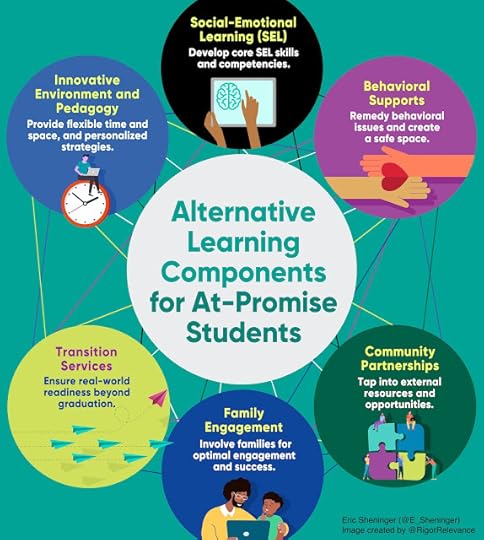
Innovative Environment and Pedagogy
Provision of an effective and supportive learning environment that enables participating at-promise learners to improve their academic performance to attain applicable performance standards and graduate from high school. Flexibility in terms of the learning environment is pivotal, including start times, small group settings, unique classroom design, work-study options, and virtual coursework. In terms of pedagogy, personalized learning strategies and project-based learning should be emphasized.
SEL
There are reasons that these learners have not experienced success in traditional education settings. Alternative learning programs emphasize services and supports that help at-promise students develop appropriate social and emotional competencies.
Behavioral Supports
While focusing on SEL is a priority, so is establishing an array of structures that address and remedy behavior issues that impact academic success while working to create a safe learning environment. Well-structured alternative learning programs use various counseling services, including intensive 1:1 and research-based classroom strategies such as Response to Intervention (RTI) and Multi-Tiered System of Supports (MTSS).
Transition Services
While graduation is the goal, so is ensuring that these students have the competence and tools to succeed in life. Curriculum and standards attainment doesn’t equate to real-world preparedness. Transitional support services to at-promise students begin as they move to/from school to alternative learning programs and should continue as they graduate from high school to ensure college, career, and citizenship readiness.
Family Engagement
As the African proverb states, “It takes a village to raise a child.” Family engagement is an essential component of any alternative learning program. At the cornerstone is effective communication, something I emphasized extensively in Digital Leadership. This involves providing routine information and educating families on how the program works, having them involved in counseling sessions, and encouraging their children to take advantage of the opportunity to move past mistakes.
Community Partnerships
Resources and opportunities are critical to assist at-promise students with reaching their potential. The local community can offer a wealth of assets, including internships, mentoring, guest speakers, field trips, jobs, and financial backing that will aid in helping these learners get on a path to success. Here is where other aspects of digital leadership come into play beyond communications. Taking control of public relations and creating a positive brand presence will go a long way to securing and building community partnerships.
We all make mistakes. We don’t want these to define us, and the same can be said for the learners we serve. Certain students need educators more than we even know. As I stated in Disruptive Thinking in Our Classrooms, “All learners have greatness hidden inside of them. It’s the job of an educator to help them find and unleash that greatness.” Alternative learning programs provide the tools and supports needed to fulfill the promise of a quality education for all kids.
October 17, 2021
Efficacy in Professional Learning
There are countless ways to grow and improve. At the individual level, intrinsic motivation drives educators to actively seek opportunities that support their diverse learning interests and needs. Social media has played a considerable role in this area over the years, demonstrating the power of Personal Learning Networks (PLNs) with learning anytime, anywhere, and with anyone. Speaking from experience, I have significantly benefited from not only engaging in digital spaces but taking what I have learned and applying it to my practice, which I can readily show when asked or communicate through my blog. Being a lifelong learner in the digital age is quite empowering.
While PLNs have grown in popularity, the most popular form of professional learning embraced by schools and districts still consists of more traditional pathways, such as bringing in guest speakers, workshops, or holding annual events. The investment in these options makes sense as variables such as time and cost can be absorbed through various funding sources while ensuring the entire staff is receives the training. Professional development days, mostly packed into the beginning of the academic year, are still the preferred mode to support staff while adhering to specific mandates. Everyone should be asking: Do these current pathways actually lead to changes in practice at scale?
I have written in the past about the need to move from professional development (PD) to professional learning. Any investment made should lead to efficacy. While mandate-focused trainings do very little to inspire the masses, one-and-done and drive-by events likewise do very little to provide educators with strategies to effectively implement the ideas or show what they look like in practice. Inspiration packed into one day typically fades when reality sets in shortly after. Motivation does matter, and I am all for keynote speakers or conference-like events as long as there is an underlying plan to ensure educators get what they need to succeed throughout the year. This is what leads to change—not a single person or standalone PD day.
Efficacy is about showing the impact of investments made in professional learning. It can be broken down into two different categories: planning and implementation. To set the stage for efficacy, we need to be cognizant of the rationale for why a particular initiative or strategy is being invested in and how it will benefit learners through improved outcomes.
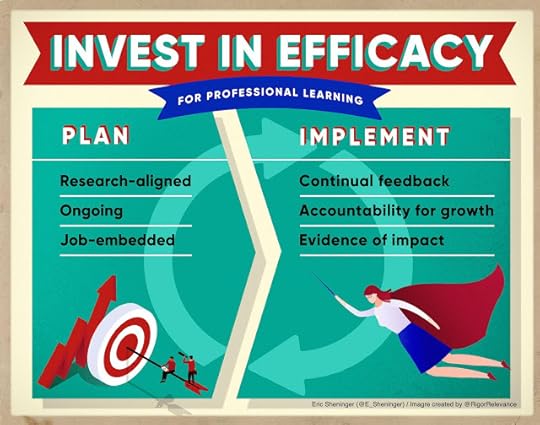
A solid professional learning plan is:
A plan is only as good as its implementation. In Digital Leadership, I shared a strategic planning process that can help set the stage for impactful professional learning. The visual provides key guiding questions and essential elements to consider to help determine efficacy. Now the challenge and opportunity are to make it happen.
Effective implementation relies on:
Continuous feedbackAccountability for growthEvidence of impactCoaching is a critical component as it provides continual support for teachers and administrators while addressing all the essential planning and implementation components. The key is to remember that coaching alone will not lead to sustainable and scalable change. That requires each school or district to build in their own feedback and accountability measures while curating evidence to show impact over time in relation to improved learner outcomes, both qualitative and quantitative.
Recently I have been involved in several ongoing projects where districts have not only made the pertinent investments but have also integrated the planning and implementation components. For example, I partnered with Jackson County School System in Georgia to work with all their school leaders over the summer on Disruptive Thinking in Our Classrooms. Over the course of the year, I am on-site in the role of coach to provide ongoing and job-embedded feedback to show efficacy. While I saw many amazing examples of innovative practices at scale, I was very impressed with East Jackson Elementary School. Through many classroom visits, I was able to see direct evidence of how the leadership team took personalized learning strategies that I presented over the summer, formulated a plan, and implemented them with fidelity. Below are a few examples.
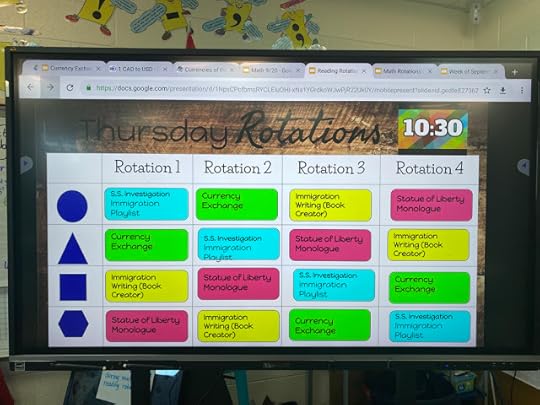
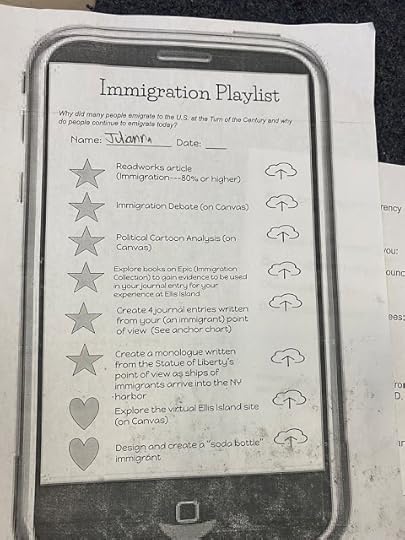
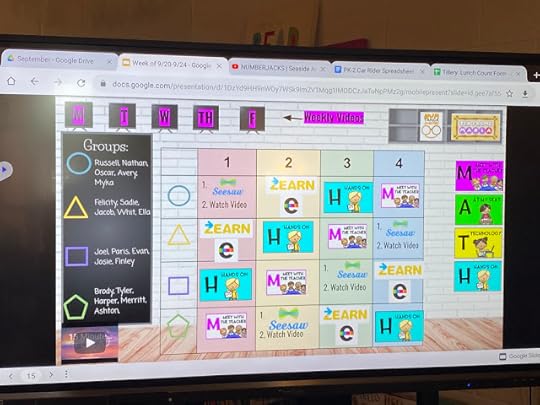
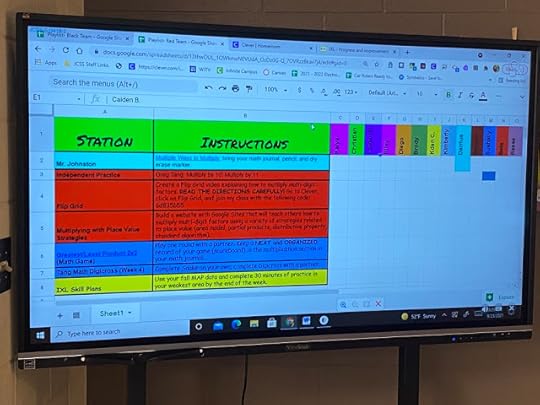
The same can be said for the Juab School District in Utah. Well over a year ago, I facilitated a district-wide workshop on personalized learning, followed up with job-embedded coaching and targeted sessions. Recently I was back again, visiting classrooms to provide feedback. There was so much growth, and I can’t begin to explain how proud I am of these teachers and administrators. Below are a few highlights.
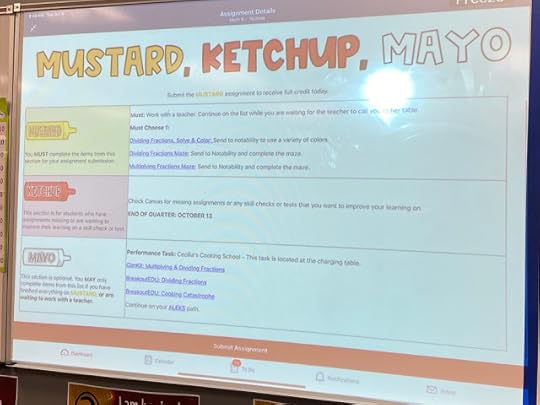
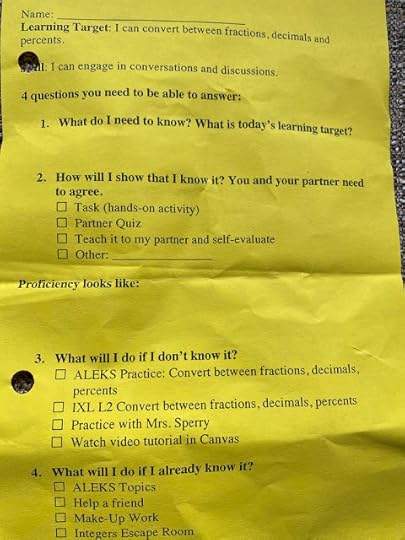
It is essential to understand the underlying principles of effective professional learning. Whether you are a teacher or administrator, you must advocate for supports that will help you succeed. I always advise schools and districts to poll their staff and then develop a comprehensive plan that will lead to efficacy, either internally or with external help. An outside lens can overcome internal bias and provide an honest assessment of where you truly are while guiding you to your desired destination. No matter the path chosen, the key is to get it right.
October 10, 2021
Seeking Out Feedback
Growth is a never-ending journey. While there is no one best way to get better at what we do, I think we can all agree that feedback is a necessity no matter the path taken. For it to impact practice, it should be practical, specific, timely, and facilitated in a positive fashion. While we know how important feedback is to our growth, the question becomes how often do we receive it in some form? I shared the following in a past post:
Feedback can be a catalyst for motivation, engagement, and finding answers to questions or problems. First and foremost, we must be open to it in some form. One way to move the needle is to seek it out from a variety of perspectives.
If you are not receiving enough feedback to either spark or sustain your growth, how are you seek it out? I can definitely improve in this area, and I really didn’t think about it much until an experience with Jackson County Schools in Georgia. One of the site visits took us to East Jackson Comprehensive High School, where I observed one of the best math lessons ever. In a nutshell, the teacher created a courtroom experience where students dove into the concepts in a relevant way. Various roles were assigned, such as jury members, prosecution, and defense, where the class used evidence to determine whether or not math problems were solved correctly. The teacher was thoroughly immersed in the lesson himself as the judge with a wig and all. As part of my notes, I wrote that this was an experience students would remember for a very long time.
Even though the lesson was amazing, it was not the best part. Near the end, the teacher took off his wig and, as a form of closure, asked the students for feedback to improve the activity in the future. The responses were fantastic and included more challenging problems, finding ways to get the jury more involved during deliberation, and finding ways for all students to report out. I couldn’t applaud enough the teacher’s willingness to be vulnerable coupled with a sincere desire to improve. To top it all off, this was also a great example of using student voice to personalize the learning experience without technology.
There are so many valuable lessons that each of us can take away from the teacher above related to effective teaching and learning, but also practical ways to seek out feedback and act on it routinely. Here are six ideas to consider:

Seize every opportunity: Don’t wait for someone else to provide you with feedback. If you do, there is a chance you might be waiting for a while. Listen intently: After asking for feedback, take in all that is provided to you. Make sure your body language clearly shows that you are paying attention and genuinely care about what is said. It goes without saying that being “present” is vital.Clarify points: After listening, verbalize what has been suggested to you while using questions to make sure that the points that have been made are clear. Doing so also shows that you were listening.Be appreciative: If you want honest feedback on a regular basis, people need to know you care. It is also essential to understand that sometimes providing ways to improve to a peer or superior in position isn’t easy for some to provide. By showing appreciation, it sets the stage for others to make efforts to seek you out to engage in feedback conversations instead of the other way aroundWrite usable points down: You don’t have to agree with everything that is provided to you. Write everything down, process, and then reflect on what has value.Take action: The value of feedback lies in how it is used to grow and improve. If it is given and nothing changes, then don’t be surprised if people stop providing it or, worse yet, turn to criticism.
Seeking out feedback is a simple act that anyone can engage in to grow. Always look to seize the moment. The real work begins once you use it to be the best iteration of yourself for those you serve.
October 3, 2021
Setting the Stage for Current and Future Learner Success
The traditional goal of any education system is to prepare students for either college or careers. Over the years, I would say that while this view still holds value, the context has changed dramatically. The world has radically evolved as a result of constantly advancing technology and the COVID-19 pandemic. With knowledge readily available and the means to seamlessly engage in digital spaces now the norm, educators need to keep pace and ensure that the strategies they use will serve learners well into the future. While this might seem like a monumental task, it is not as difficult as one might think.
While preparation for college and careers might remain a focus, it is important to understand that there is no uniform recipe for success as this varies significantly between different learners. Herein lies both a challenge and opportunity for educators. As I shared in Disruptive Thinking in Our Classrooms, our world needs students who have the competencies to replace conventional ideas with innovative solutions to authentic problems. There are many different pathways to accomplish this goal that I discuss in detail in the book. However, a more holistic approach can be taken to set the stage for developing a learner’s ability to accomplish any aim or purpose they set out to achieve.
When designing lessons, projects, or assessments, consider whether or not they empower learners to:
Engage in problem-solvingCollaborate with peersThink critically and creatively Communicate clearly and accurately Develop open-mindedness Make real-world applicationsReflect on learningAnalyze, reason, and evaluateSetting the stage for learner success requires a commitment beyond just the people that have direct contact with students. It is important to note that administrators play a crucial role in how they support their teachers with feedback on the elements listed above. Pedagogical leadership can pave the way.
While the elements above are undoubtedly essential, it should be noted that not every lesson, assignment, or assessment will include all of these. Hence the need to develop a system of norms that can be implemented routinely that will either directly address or set the stage for disruptive thinking. Below is a checklist of sorts containing questions that can be used to reflect on daily practice and serve as a means for growth:
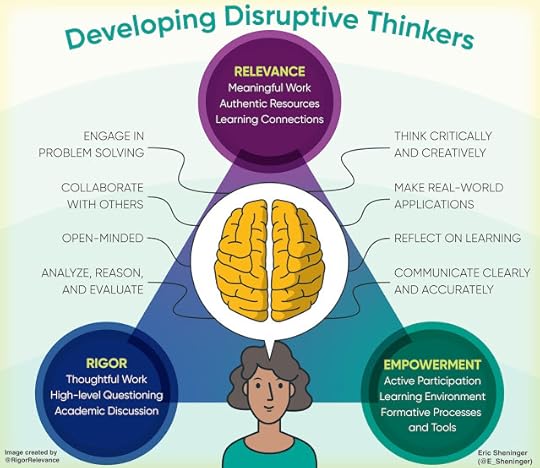
Rigor – How are all learners being challenged to think through scaffolded questions and tasks? Is the work that they engage in thoughtful and providing an opportunity for discourse and collaboration? Relevance – How are learners applying their thinking in meaningful and purposeful ways? Are they afforded the opportunity to leverage authentic resources and make interdisciplinary connections between various concepts?Empowerment – Do learners own their experience in the classroom or school through personalized strategies that promote voice, choice, path, pace, and place? Are they able to access and use a variety of tools to construct new knowledge and demonstrate what they have learned? How has the learning environment changed to respond to individual strengths and weaknesses?
Ensuring current and future learner success doesn’t rely on a technology tool or a passing fad. It is achieved through a dynamic combination of strategies that future-proof learning for all kids so that they can thrive in a disruptive world. Try not to overthink things. Even though the world will continue to change rapidly, you have the knowledge, tools, and mindset to equip kids and put them all on a path towards success.
September 26, 2021
A Five-Step Process for Resolving Conflict
When it comes to a thriving school culture, many factors can derail progress. While lack of resources, too many mandates, unclear vision, and a lack of accountability might be at the top of the list, I feel that conflict, especially internal, possesses the greatest threat to achieving goals and improving outcomes. While this has always been a part of human nature, it is interesting to observe how it plays out at an individual level. Some people avoid conflict at all costs, while others actively look to incite it for reasons that don't make much sense. Regardless of one's stance on the issue, the result can erode culture.
I wish I could say that conflict is avoidable, but the fact of the matter is that it is not. Conflict materializes when one person or group perceives that someone else or others have taken actions to adversely affect something that is cared about. The adverse effects can include lapses in productivity, leaving for another position, work disruptions, falling behind on deadlines, absenteeism, and emotional stress. It goes without saying that none of these potential outcomes are positive. Thus, it is crucial for all educators to have a plan to address conflict using a proactive approach. While the purpose of this post focuses on adult interactions, the same methodology explained below can be used to help resolve issues between students.
"When you have a conflict, that means that there are truths that have to be addressed on each side of the conflict. And when you have a conflict, then it's an educational process to try to resolve the conflict. And to resolve that, you have to get people on both sides of the conflict involved so that they can dialogue." - Dolores Huerta
Here is a simple five-step process that can be used to resolve conflict.
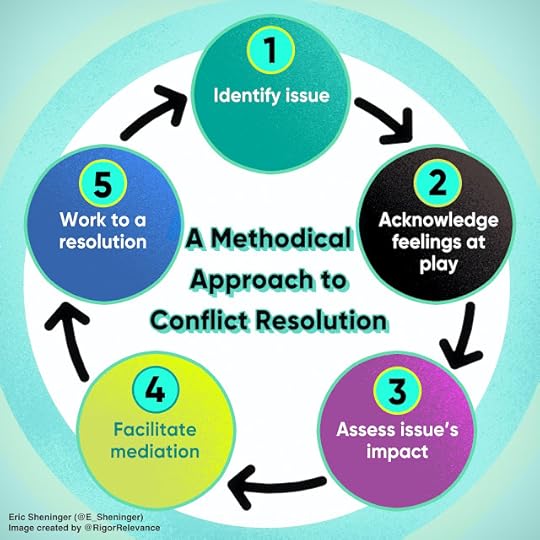
Identify the issue or problem: Typical catalysts include gossip, unclear communication, insensitivity, bullying, misunderstandings, and poor work ethic. As mentioned previously, some people live to start and sustaining conflict. If this is the case, it is vital to be proactive in dealing with these people so that they don't constantly erode culture. Sometimes the best resolution, in this case, is termination.
Determine the feelings at play – Every catalyst that sparks conflict is fueled by various feelings such as anger, animosity, hurt, embarrassment, fear, and frustration. Knowing what feelings are being triggered is critical for the next step.
Figure out the impact of the issue or problem – Earlier in this post, I identified some general negative impacts associated with conflict. Other topics such as individual performance, group dynamics, relationships with students and families can materialize. Once the specific issue or problem is identified, a course of action can be put in place.
Facilitate a mediation: Once all pertinent information is gathered, get people in a room, allow them to air their concerns, ensure there is equity in terms of speaking time, and listen intently without passing judgment. Mediation is about both parties airing their grievances to set up reconciliation through an agreed-upon resolution.
Work to a resolution – Here is where you need to be actively involved and embrace the role of negotiator. A solid first step is to help the parties understand their way of dealing with conflict. Only then can a resolution be achieved. Consider using the Thomas-Kilmann Conflict Mode Instrument (TKI). There are five major styles of conflict management—collaborating, competing, avoiding, accommodating, and compromising. The end goal is to have each party agree on a resolution where they see a mutual benefit and the impediment to a positive culture is removed.
Effectively identifying, understanding, and managing conflict is critical to both organization and individual success. In the end, the overall goal is to control issues that can spiral out of control. However, conflict resolution can also lead to setting up more positive outcomes related to culture once people or groups learn to understand and appreciate one another more. After all, some of the best ideas materialize through conflict.
September 19, 2021
Closing the Digital Divide with an Emphasis on Learning
Sponsored post
Bridging the digital divide is a monumental task. It begins with providing learners with access to devices and high-quality Internet. For all the challenges it has placed on school systems, the pandemic managed to close the gap in this area significantly. I watched some districts go 1:1 in a matter of days while also providing mobile hotspots for disadvantaged students. While this represents a good start, there is much more to the process if the goal is to impact learning. With access to technology, there needs to be an equal focus on supporting educators on how to use it in a purposeful way that leads to improved outcomes. Here is where Verizon is stepping up.
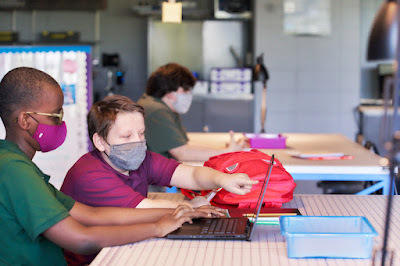
Connectivity is a lifeline to progress these days for students. Verizon is not only working to increase access to close the digital divide, but they are also providing critical support to improve learning. To that end, they recently launched Verizon Innovative Learning HQ, an amazing next-generation learning portal that is completely FREE! Highlights include the following:
Standards-aligned lesson plans across an array of content areas: There is a great deal to explore here. Each lesson contains an estimated time for completion, materials, technology to be used, and appropriate grade level. There are also learning outcomes aligned to Common Core, ISTE, and Next Generation Science Standards. As I explored, I also discovered full-length courses that students can take.Augmented and virtual reality apps (AR/VR) – Engagement is always on the minds of educators. With these tools, students can dive deeper into concepts while also collaborating with their peers. Using the camera on a mobile device, augmented reality overlays images/media over the real world. It is a social experience, as opposed to virtual reality, where a single student would wear goggles that would obstruct them from their surroundings. There is so much potential for these tools to engage and empower learners.Professional development – Through a partnership with Digital Promise, Verizon Innovative Learning HQ provides self-paced courses that educators can take on topics such as remote learning, hybrid instruction, digital inclusion, and blended learning. If the relevancy of the topics wasn’t enough, there is also an option for educators to be recognized for their learning. A unique aspect provided by Digital Promise is the ability to earn micro-credentials for certain completed sessions. These asynchronous learning opportunities offer much-needed flexibility to educators. For more resources on remote and hybrid learning, be sure to check out my collection HERE.As the world continues to change, learners need equitable access while educators require the tools and support to create powerful learning experiences. These disruptive times have taught us not to prepare learners for something but to prepare them for anything! To accomplish this task, they will need technology and the means to use it in a purposeful way that develops critical competencies. As I shared in Disruptive Thinking in Our Classrooms, learners need to be empowered to replace conventional ideas with innovative solutions to authentic problems. Hence the need to close the digital divide while making sure both learners and educators have the tools to support this goal.
September 12, 2021
Four Practical Ways to Blend
When it comes to blended learning, it is essential first to have an underlying understanding as to why this pedagogical strategy is valuable in the classroom. Let’s take a step back before diving into the nuts and bolts. Over the years, I have written a great deal about personalization, which is basically a shift from “what” to “who” as a means for students to demonstrate more ownership over their learning. What is taught or on the test has little value if the diverse needs of learners aren’t addressed. The same could be said if all kids are learning the same thing at the same time in the same way.
The path to equity begins with a vision where all learners get what they need when and where they need it, regardless of the learning environment. This is the essence of personalization. While there are many strategies to personalize, blended pedagogies represent the most practical means. While you don’t need technology to personalize, it is required to blend. Here is my definition shared in Disruptive Thinking in Our Classrooms that makes a distinction between instruction:
Blended instruction is what the teacher does with technology. Blended learning is where students use tech to have control over path, place, and pace.
Over time through my extensive work with schools, I have identified the four most practical ways to personalize through blended learning. These include station rotation, choice activities, playlists, and the flipped approach. While each has unique benefits, they all help move teaching and learning from a state of equality to equity. The image below is my attempt to capture these significant changes.
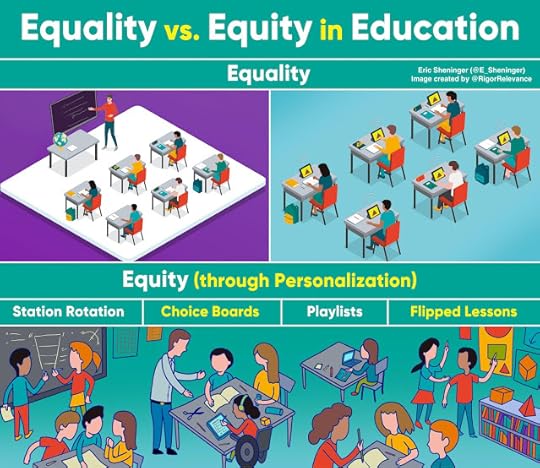
I realized that I have separate posts and images on all four of these blended learning strategies and thought it might be a good idea to curate this information that educators have found valuable to create a resource. Below I have briefly summarized each approach and encourage you to click on the link for more detailed information.
Students are grouped based on data and move through a variety of set activities typically consisting of targeted instruction with the teacher, collaborative exercises, independent work, and online tasks that are personalized for individual learners. The teacher establishes a block of time for each station, and students visit each one during a class period followed by some sort of forma¬tive assessment.
These allow students to select a set number of activities to complete from numerous options. Typically, they are arranged in a choice board or must-do/may-do format. Often a teacher will differentiate by having different versions. Students do not complete all of the activities.
A series of individualized assignments that students work through at their own pace while following the path of their choice. As students complete a task, they either color in the corre¬sponding box on a digital sheet next to their name or check off each box on a paper worksheet. Unlike choice activities, all tasks are completed.
Students watch a short, direct instruction video or consume other forms of content outside of school at their own pace while communicating with peers and teachers using online tools. While in school, students work to actively apply what they have learned through concept engagement and empowering learning activities with assistance from the teacher.
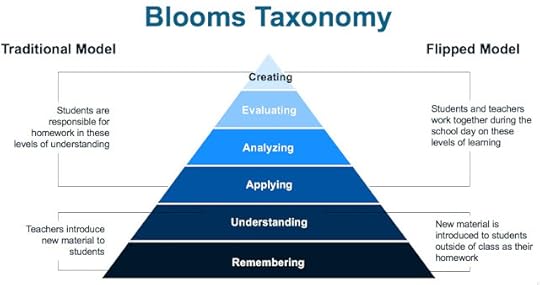
All the blended learning strategies listed above allow educators to better use their time with students while opening the door to more significant equity through personalization. It is important to remember that instruction still plays an important role, especially in terms of setting up the blended pathway of choice. It is up to the teacher to determine when and the extent to which each strategy is implemented.



